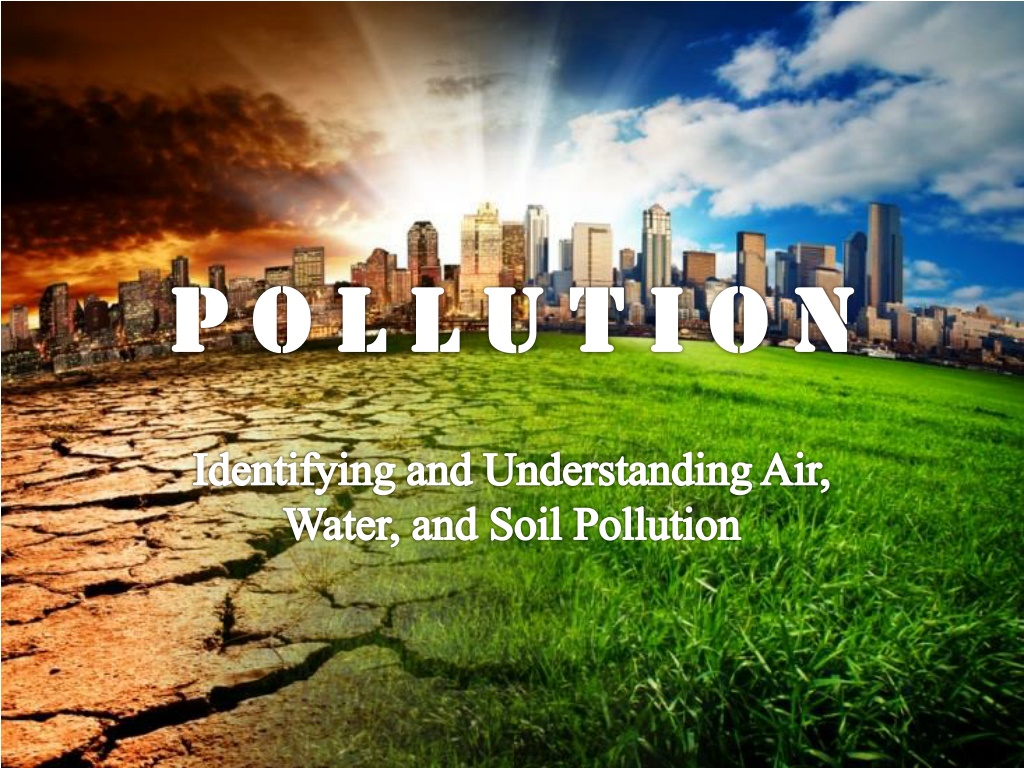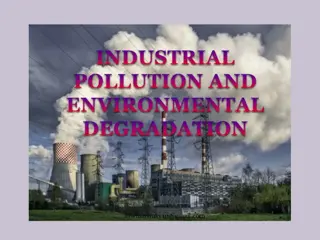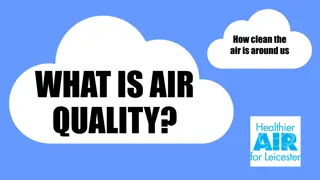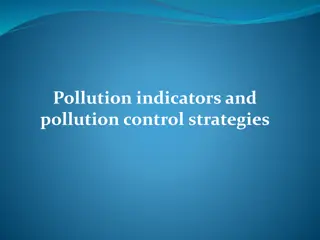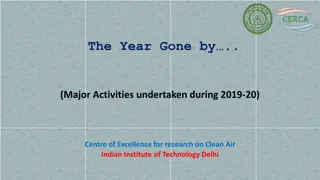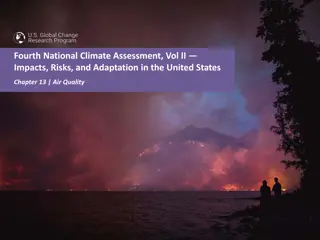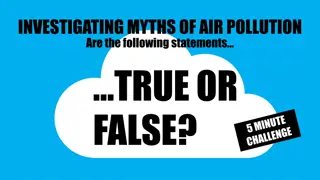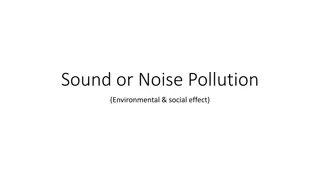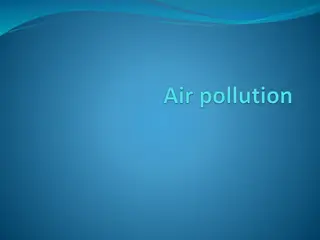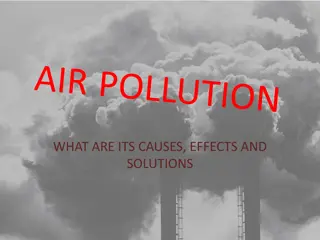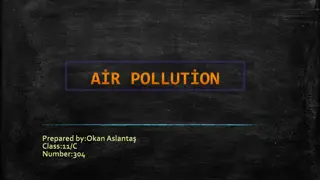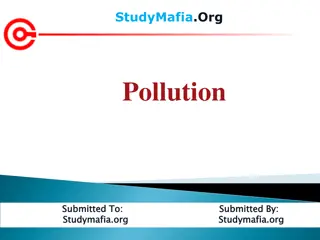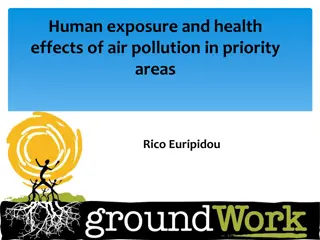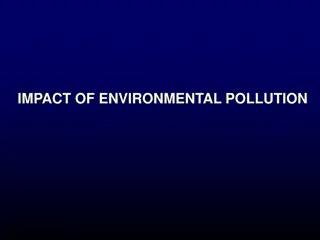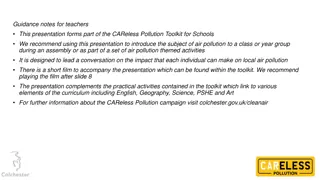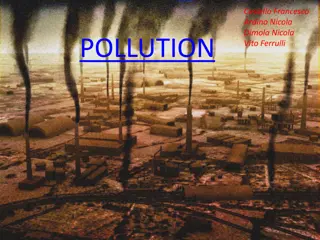Understanding Air Pollution: Causes, Impacts, and Solutions
Air pollution is a pressing issue caused by human activities like industrial emissions and transportation. It poses significant health risks to both individuals and the environment. This comprehensive guide delves into the history, primary and secondary pollutants, urban vs. rural impacts, and major outdoor air pollutants related to air pollution. Understanding these aspects is crucial for tackling this global environmental challenge effectively.
Download Presentation

Please find below an Image/Link to download the presentation.
The content on the website is provided AS IS for your information and personal use only. It may not be sold, licensed, or shared on other websites without obtaining consent from the author. Download presentation by click this link. If you encounter any issues during the download, it is possible that the publisher has removed the file from their server.
E N D
Presentation Transcript
P O L L U T I O N Identifying and Understanding Air, Water, and Soil Pollution
Air Pollution Atmosphere need to know: Air is more dense at sea level 75-80% of air mass found in troposphere Atmosphere contains 78% N, 21%O, and 1% trace gases like, methane, nitrous oxide, ozone, argon, water vapor, and carbon dioxide. Also soot, and dust. Ozone (3 O2+ UV 2 O3) blocks 95% UV Ozone keeps O from forming photochemical ozone, a harmful pollutant near the ground
Air Pollution What is Air Pollution? the presence of chemicals in the atmosphere at concentrations high enough to harm organisms, ecosystems, and human made items. Effects range from annoying to lethal. Natural sources include dust, smoke, and VOC s released by certain plants. Most are spread out or removed by chemical cycles, precipitation, and gravity. Human inputs of air pollution are mostly due to industry, transportation, and densely populated areas.
Air Pollution (a glance through time) Humans burning wood in poorly ventilated space. Middle ages haze of wood smoke around urban areas. Industrial Revolution required burning coal which led to great increases in respiratory diseases. Late 1800 s saw people in London dying from the pea soup fogs caused by dense coal smoke mixtures. 1952 a yellow fog killed approximately 4000-12000 Londoners. British Parliament passes Clean Air Act of 1956. US in the 1940 s experienced severe air pollution. Donora, Pennsylvania experienced first air pollution disaster in October 1948. A 5 day toxic fog sickened 6,000 people and killed 20. New York City 1963: 300 people die and thousands more sickened. US develops the Clean Air Act of 1970
Air Pollution Primary Pollutants harmful chemicals emitted directly into the air from natural processes and human Secondary Pollutants formed when primary pollutants react with one another or with basic components of air to form new harmful
Air Pollution Urban vs. Rural? What about the wind? Developed vs. Developing countries? 1.1 billion people live in urban areas where outdoor air is unhealthy. (WHO) Developing Countries do not have Air Pollution Laws. Indoor air pollution is major problem for the poor Air Pollution is no longer a regional problem it is a global problem.
Major Outdoor Air Pollutants Carbon Oxides CO, CO2; form during the incomplete combustion of carbon containing materials. Ex.(motor vehicle exhaust, tobacco smoke, open fires, inefficient stoves, and forest and grassland fires. CO reacts with hemoglobin in red blood cells and reduces the ability of blood to transport oxygen throughout the body. 93% of CO2results from the carbon cycle, the rest comes from human activities such as deforestation and burning of fossil fuels. CO2levels have been on the rise since the industrial revolution and documented well since the 1950 s.
Major Outdoor Air Pollutants Nitrogen Oxides and Nitric Acid - NO, HNO3; nitrogen and oxygen gas react at high combustion temperatures in automobile engines and coal-burning plants. Lighting and certain bacteria also produce NO. NO2reacts with water vapor to create HNO3and nitrate salts (NO3-) which cause harmful acid deposition. Both NO and NO2play a role in forming photochemical smog. Nitrous oxide (N2O) a greenhouse gas is emitted from fertilizers, and animal wastes and is produced by burning fossil fuels. Nitrogen Oxides can irritate the eyes, nose, and throat; aggravate lung ailments and increase susceptibility to respiratory infections. Nitrogen Oxides can also suppress plant growth and reduce visibility when they are converted to nitric acid and nitrate salts
Major Outdoor Pollutants Sulfur dioxide and sulfuric acid SO2, H2SO4; about 1/3 of SO2in the atmosphere comes from natural sources. The other 2/3 come from human sources, mostly from burning sulfur containing coal, oil refining and smelting of sulfide ores. SO2can be converted to aerosols of H2SO4and suspended particles of sulfate (SO42-) salts which lead to acid deposition. Sulfur dioxide, sulfuric acid droplets, and sulfate particles reduce visibility and aggravate breathing problems. SO2and H2SO4can damage crops, trees, soils, and aquatic life in lakes. They also corrode metals and damage paint, paper, leather, and stone on buildings and statues.
Major Outdoor Air Pollutants Particulates(Suspended Particulate Matter) SPM; Consists of a variety of solid particles and liquid droplets that can remain suspended in the air for long periods of time. 62% of SPM exists from natural sources, dust, smoke, sea salt. 38% exists comes from human sources, coal burning power plants, motor vehicles, plowed fields, road construction, unpaved roads, and tobacco smoke. Since 1990 more than 2000 studies link SPM to adverse health affects. According to the EPA and Harvard School of Public Health, particulate air pollution is responsible for 60,000-70,000 premature deaths a year.
Major Outdoor Air Pollution Particulates Continued. . . The most harmful forms of SPM are fine particles ( average diameter of less than 10 micrometers) and ultra fine particles (average diameter of 2.5 micrometers). These particles can irritate the nose, throat, damage lungs, aggravate asthma and bronchitis, and shorten life. Toxic particulates such as lead, cadmium, and PCB s (polychlorinated biphenyls) can cause mutations, reproductive problems, and cancer. Particulates also reduce visibility, corrode metals, and discolor clothes and paints.
Major Outdoor Air Pollution Ozone O3; a major component of photochemical smog. Ozone found in the troposphere is considered bad ozone, while stratospheric ozone is considered good ozone. Ozone can cause coughing and breathing problems, aggravate lung and heart disease, reduce resistance to colds and pneumonia, irritate eyes, nose, and throat. Ozone also damages plants, rubber in tires, fabrics, and paints.
Major Outdoor Air Pollutants Volatile Organic Compounds (VOC s); Organic compounds that exist as gases in the atmosphere. Most are hydrocarbons such as isoprene and terpenes, emitted by plants, and methane which is a greenhouse gas. 1/3 of methane comes from natural sources such as plants, wetlands, and termites. The rest come from human sources primarily rice paddies, landfills, oil and natural gas wells, and cows. Other VOC s including benzene, vinyl chloride, and trichloroethylene (TCE) are used as industrial solvents, dry cleaning fluids, and components of gasoline, plastics, drugs, synthetic rubber, and other products.
Major Outdoor Air Pollutants Volatile Organic Compounds continued. . . Benzene is found in motor vehicle and power plant emissions, and tobacco smoke. Long term exposure can lead to leukemia, numerous blood disorders, and immune system damage. Short term exposure to high levels can cause dizziness, unconsciousness, and death.
Major Outdoor Air Pollution Lead (Pb); since it is a chemical element lead does not break down in the environment. Lead is a potent neurotoxin and can damage the nervous system. Each year 12,000-16,000 American children under age 9 are treated for acute lead poisoning. About 200 die. 30% of survivors suffer from palsy, partial paralysis, blindness and mental retardation. Children under 6 and unborn fetuses are especially vulnerable to lead exposure
Major Outdoor Air Pollution Lead continued. . . Between 1976 and 2000, the percentage of US children ages 1-5 with blood lead levels above the safety standard dropped from 85% to 2.2% Why? The US banned the use of leaded gasoline and lead based paint in 1976 to have a complete phase out by 1986. US centers of Disease Control estimate that at least 310,000 children still have unsafe blood levels of lead caused by exposure to lead based paint found in approximately 38 million homes built before 1960, and lead contaminated dust in deteriorating buildings.
Major Outdoor Air Pollution Lead continued. . . Lead has been found in lipsticks, toys, and can leach from water pipes and faucets. Developing countries still battling with high lead poisoning issues, predominately due to the use of leaded gasoline.
Major Outdoor Air Pollution Lead (Pb) Poisoning Prevention Phase out lead gasoline worldwide Phase out Waste incineration Ban use of lead solder Ban use of lead in computer and TV monitors Ban lead glazing for ceramic ware used to serve food Ban candles with lead cores Test blood for lead by age 1 Control Replace lead pipes and plumbing fixtures containing lead solder Remove leaded paint and lead dust from older homes and apartments Sharply reduce lead emissions from incinerators Remove lead from TV sets and Computer monitors before incineration or land disposal Test for lead in existing ceramic ware used to serve food Test existing candles for lead Wash fresh fruits and vegetables
Industrial Smog Ammonium sulfate (NH4)2SO4 Ammonium sulfate salts and soot are what cause smog to appear gray in color. Therefore it is sometimes called gray air smog. Ammonia (NH3) Sulfuric acid (H2SO4) Water Vapor (H2O) Carbon Monoxide (CO) and Carbon dioxide (CO2) Sulfur trioxide (SO3) Oxygen (O2) Burning Coal and oil Mixing with oxygen (O2) Sulfur dioxide (SO2) Sulfur in coal and oil Carbon in coal and oil
Photochemical Smog PAN s and other pollutants Photochemical smog exists in all modern cities. NO2, O3, and PAN s are considered to be Photochemical oxidants. Hotter days lead to high levels of ozone and photochemical smog. VOC s Ozone (O3) O2 Nitric Oxide + Oxygen H2O and UV radiation Nitrogen dioxide (NO2) Peroxyacyl nitrates (PAN s) O2 Hydrocarbons Nitric oxide (NO) O2 Nitrogen (N) in fossil fuel
Factors for increasing or decreasing Air Pollution Decreasing Particles heavier than air settle out. Rain and snow cleanse the air. Salty sea spray wash out particles and water-soluble pollutants as air flows from land to sea. Winds sweep pollutants diluting them. Natural chemical reactions remove pollutants. Acid Deposition. Increasing Urban buildings can slow wind. Hills and mountains can reduce air flow. High temperatures promote chemical reactions. VOC s from plants and trees in wooded urban areas can play major role in photochemical smog formation. Grasshopper effect air pollutants from the tropics make their way to the Arctic Temperature Inversions trap pollutants
Acid Deposition Can be wet or dry. Has been occurring since the industrial revolution. Is a regional air problem for areas downwind of coal-burning facilities and urban areas with many motor vehicles. Is neutralized by Limestone soils that buffer the acid affect. Harms thin acidic soils which provide no such buffering. Leaches toxic metals (Pb and Hg) into lakes and water sources, which can bioaccumulate in fish, mammals, and birds. Lowers pH of aquatic ecosystems harming fish. (pH < 4.5) Harms crops by lowering soil pH Effects Forests by leaching calcium and magnesium from the soils and allowing other metals such as Al, Cd, Hg, and Pb which weaken trees.
Acid Deposition Prevention Reduce coal use Burn low sulfur coal Increase use of renewable energy resources Remove SO2 particles and NOx from smokestack gases Remove NOx from motor vehicular exhaust Tax emissions of SO2 Reduce air pollution by improving energy efficiency Cleanup Add time to neutralize acidified Lakes Add phosphate fertilizer to neutralize acidified lakes
Indoor Air Pollution The most threatening indoor air pollutants are smoke and soot from wood and coal cooking fires, and chemicals used in building materials and products. Poses a much greater threat to human health than outdoor pollution. Since 1990 EPA has placed indoor air pollution at the top of the list for 18 sources of cancer risk. Particulates such as pollen, pet dander, dust mites, and cooking smoke particles can irritate lungs, cause asthma attacks, itchy eyes, runny nose and lung disease. Toxic airborne spores of molds and mildew can cause headaches and allergic reactions. They can aggravate asthma, and other respiratory diseases. Sick Building Syndrome effects 1 in 5 commercial buildings in the U.S.
Indoor Air Pollution Four most dangerous indoor air pollutants in developed countries are tobacco smoke, formaldehyde, radioactive radon-222 gas, and very small particles. Exposure to formaldehyde can lead to an increase risk of Lou Gehrig's Disease (ALS). In 2008 CDC measured unhealthy levels of indoor levels of formaldehyde in many of the trailers and mobile homes used for Hurricane Katrina victims. Radon-222 is produced by the natural radioactive decay of Uranium-238. Can accumulate in buildings where it decays to Polonium-210 and can cause lung cancer. Smokers and former smokers tend to be the most susceptible to radon-related lung cancers. (90%)
Air Pollution Laws and Regulations Clean Air Acts 1970, 1977, 1990 National Ambient Air Quality Standards CO NOx SO2 SPM O3 Pb Primary Standard to protect human health Secondary Standard prevent environmental and property damage Emission Standards Hazardous Air Pollutants (HAP s) that cause health and ecological effects. Toxic Release Inventory (TRI) requires 21,500 refineries, power plants, hard rock mines, chemical manufactures, and factories to report their releases and waste management methods for 667 toxic chemicals.
Air Pollution Laws and Regulations Environmental Scientists applaud the success of U.S. air pollution control laws but point to the following deficiencies: The US continues to depend on pollution cleanup rather than prevention. US congress failed to increase fuel-efficiency standards for cars, SUV s, and light trucks. Regulations of emissions from motorcycles and two cycle gasoline engines remain inadequate. There is little to no regulation of air pollution from oceangoing ships in American ports. Airports are exempt from many air pollution regulations. Laws do not regulate emissions of greenhouse gas CO2. Ultrafine particles are not regulated. Urban ozone levels are still too high in many areas. The laws have failed to deal seriously with indoor air pollution. There is need for better enforcement of the Clean Air Acts.
Emissions Trading /Cap and Trade Producers of air pollutants can buy and sell pollution rights. Proponents argue it is cheaper than government management. Critics say it allows older facilities to shirk their environmental responsibilities to reduce their pollution. System tends to move pollutants to other areas without any real reduction in air pollution. What about mercury?
Stationary Source Air Pollution Solutions Prevention Burn low-sulfur coal Remove sulfur from coal Convert coal to a liquid or gaseous fuel Shift to less polluting energy sources Dispersion or cleanup Disperse emissions above thermal inversion layer with tall smokestacks. Remove pollutants after combustion. Tax each unit of Pollution produced
Motor Vehicle Air Pollution Solutions Prevention Use Mass Transit. Walk or Bike. Use less polluting fuel. Improve fuel efficiency. Get older polluting cars off the road. Give large tax write-offs or rebates for buying low- polluting, energy efficient vehicles Cleanup Require emission control devices. Inspect car exhaust systems twice a year. Set strict emission standards
Indoor Air Pollution Solutions Prevention Clean ceiling tiles and line AC ducts to prevent release of mineral fibers. Ban smoking or limit it to well- ventilated areas. Set stricter formaldehyde emissions standard for carpet, furniture, and building materials. Prevent radon infiltration. Use office machines in well ventilated areas. Use less polluting substitutes for harmful cleaning agents, paints, and other products. Cleanup or dilution Use adjustable fresh air vents for work spaces. Increase intake of outside air. Change air more frequently. Circulate a building s air through rooftop greenhouses. Use efficient venting systems for wood-burning stoves. Use exhaust hoods for stoves and appliances burning natural gas.
Air Pollution Solutions Prevention Improve energy efficiency to reduce fossil fuel use. Rely more on lower- polluting natural gas. Rely more on renewable energy. Transfer energy efficiency, renewable energy, and pollution prevention technologies to developing countries. Cleanup or Dilution Reduce Poverty. Distribute cheap and efficient cookstoves or solar cookers to poor families in developing countries. Reduce or ban indoor smoking. Develop simple and cheap tests for indoor pollutants such as particulates, radon, and formaldehyde.
What can you Do? Indoor air Pollution Test for radon and formaldehyde inside your home and take corrective measures as needed. Do not buy furniture and other products containing formaldehyde. Remove your shoes before entering your house to reduce inputs of dust, lead, and pesticides. Test your house or workplace for asbestos fiber levels, and check for any crumbling asbestos materials if it was built before 1980. Do not store gasoline, solvents, or other volatile hazardous chemicals inside a home or attached garage. If you smoke, do it outside or in a closed room vented to the outside. Make sure that wood burning stoves, fireplaces, and kerosene/gas burning heaters are properly installed, vented, and maintained. Install carbon monoxide detectors in all sleeping areas.
